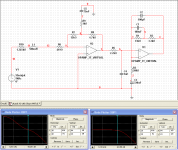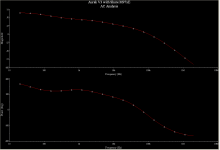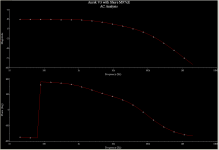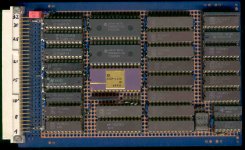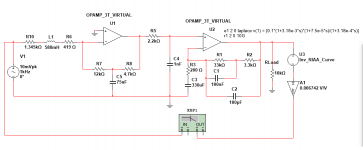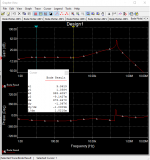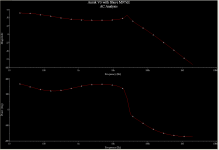Thanks. I did Google it eventually. Excuse me but I'm still not quite in da 21st century.Short description : https://en.wikipedia.org/wiki/Matched_Z-transform_method
I've played with it, don't like it .,, but have never done anything serious with it.
EqualiserAPO doesn't fit my live listen workflow, but for ripping vinyl I can use anything on any platform as long as I don't have to buy a new computer to run it  . This is as much about the journey as arrival.
. This is as much about the journey as arrival.
A totally flat pre-amp is a little way out though as playing in transconductance MM land right now which gives the HF roll off. I will be glomming Wayne's flat MC board at some time (unless Wayne has got PCBs for this one as feel I should support him). It may not match your legendary efforts but its still in spitting distance using penny parts.
A totally flat pre-amp is a little way out though as playing in transconductance MM land right now which gives the HF roll off. I will be glomming Wayne's flat MC board at some time (unless Wayne has got PCBs for this one as feel I should support him). It may not match your legendary efforts but its still in spitting distance using penny parts.
George & Bill, is EqualizerAPO something yus guys are willing to use?
If so, I'll start work on a small simple IIR that incorporates Scott's RIAA as well as EQ for the M97 (I think) that George measured for Bill.
Any preference for 44.1kHz or 48kHz? I take it the idea is to use a flat preamp which might be Wayne's or Guru Wurcer's.
Thanks Ricardo for asking.
I consider DSP RIAA only for ripping and this for the advantageous scenario of recording flat, doing the declicking (*) on the flat file and then applying DSP RIAA.
But you may very well work on such an idea! There are more than two people reading this thread
Any preference for 44.1kHz or 48kHz?
48KHz is more generic in the DSP world than 44.1KHz
I may be a little heretical on this but on the subject of frequency response I don’t neglect the results of the signal generator in series with the cartridge. Please look back here,We still have to decide which Test Record to believe.
http://www.diyaudio.com/forums/analogue-source/303389-mechanical-resonance-mms-68.html#post5061869
the blue line (signal generator) is quite close to the yellow line (HFN freq sweep), plus the signal generator test provides totally consistent and repeatable results.
A totally flat pre-amp is a little way out though as playing in transconductance MM land right now which gives the HF roll off.
Bill, consider that Aurak V3 besides it’s total analog RIAA preamp use,
allows (with a minimum of desolder) for utilising only it’s 1st stage flat, or it’s first stage with HF roll off, and also it’s second stage flat .
(*) I e-mailed daviesaudio@gmail.com. two days ago for purchasing the ClickRepair through Paypal but I have not yet received a reply. Meanwhile, I’ll play with an old trial version of the SW
George
Bill, your density is normal. I was wrong.
The first stage of Aurak can’t be used as a flat preamp.
So the two options are Aurak to be used either as the intended RIAA preamplifier, or as a preamplifier with the 2120Hz roll off by placing a short across R1.
R2 can be adjusted to control the gain of the second stage.
George
The first stage of Aurak can’t be used as a flat preamp.
So the two options are Aurak to be used either as the intended RIAA preamplifier, or as a preamplifier with the 2120Hz roll off by placing a short across R1.
R2 can be adjusted to control the gain of the second stage.
George
Attachments
Actually, much more than that.
That's not what you posted.
# optimization block =============================
# Optimization is done through z2 and by manually adjusting p2 and
# is most accurate for RIAA eq
gpapag said:I may be a little heretical on this but on the subject of frequency response I don’t neglect the results of the signal generator in series with the cartridge.
My method takes into account ALL response wriggles including those introduced by loading, preamp ...I may be being dense but as the transimpedance loading effectively puts your HF pole at 150Hz. If you don't take the free roll off then that's an extra 20dB of gain that you need to add which can only make noise worse?
We just have to trust what we measure on the Test Record. It can also correct the cartridge/arm bass bump.
But for de-clicking, Wayne's flat preamp without EQ is probably best. The less EQ, the shorter the clicks and the easier to identify & kill them.
BTW, the transimpedance is probably (in theory) one of the best LN methods and this is independent of the gain required. Aurak doesn't take full advantage of it. But it does introduce EQ which will lengthen pops & clicks.
Also if DSP EQ something like a speaker or cartridge, what you DON'T EQ is as (if not more) important than what you EQ.
There are many naive digitial EQ methods that give poor results because of this isn't take into account .. some from really big names in academia & industry.
Last edited:
That's not what you posted.
That's some old script I quicly made about a year ago and even in that script p2 and z2 are variables! You sure noticed the mention in my earlier post that I be able to prepare these filters with different quality characteristics ... using and changing only value z2 for that won't work.
Last edited:
Bill, your density is normal. I was wrong.
The first stage of Aurak can’t be used as a flat preamp.
So the two options are Aurak to be used either as the intended RIAA preamplifier, or as a preamplifier with the 2120Hz roll off by placing a short across R1.
R2 can be adjusted to control the gain of the second stage.
George
You might want to run that example out to 2 MHz --

That's some old script I quicly made about a year ago and even in that script p2 and z2 are variables! You sure noticed the mention in my earlier post that I be able to prepare these filters with different quality characteristics ... using and changing only value z2 for that won't work.
Sorry I missed that, when all poles and zeros are adjusted simple optimizers don't work. Adjusting only the last two still under constrains the problem. I was going correct my oversight but the site went down for me last night, I apologize.
Last edited:
You might want to run that example out to 2 MHz --
Here it is.
(load is 10KOhm)
George
Attachments
We had a similar problem when we made our first 16 bit DSP multiplier, how do you test it? Try all 2**32 possible inputs and check each one?
But you did a good job!
Gerhard's FIR-Filter, 1984:
The algorithm was first written and debugged in Turbo Pascal on a Z80. Then the Pascal programm was divided into states so that at most one data and one address transaction were done in parallel. The resulting state machine was rewritten for CUPL on a VAX11, translated, simulated, optimized and sliced to many PALS by CUPL. Barring one wire wrap error, the board worked right away.
Attachments
But you did a good job!
The designer was a REAL character, he once told Bob Adams that he didn't know what he was talking about.
Here it is.
(load is 10KOhm)
George
I wonder what i am doing wrong, i see a resonance at ~230kHz. The graphs/simulation are corrected for RIAA and gain:
Attachments
You left out the 1K resistor in series with the 75 nF cap. That looks like an oscillator circuit without the resistor.
Homer Simpson moment.
Well I've finally decided what to rip my vinyl with. After much hunting I did find a unit for SPDIF to USB DA2USB - Digital Audio to USB Interface , but I'd have to solder it up and box it and then box up the TI PCM4222 EVM, all doable, but given I'm 2 years behind on boxing* things up I'm going to be scoring a scarlett 2i2 as it gets me up and running, and will still be useful even if I decide to go with the higher performance solution in the future. I'm still not totally sold on having seperate gain controls left and right with no marks on the front panel, but minor problem in the grand scheme!
So in a month I should be ripping. Or back to where I was when I first got a sound card for this purpose in 2000 that I never hooked up .
.
* Since remarrying I have the advantage of a wife who likes music and allows my projects. The drawback is that she also wants the electronics to look nicer so has final veto on all box designs. This stops me just bunging things into whatever enclosures I have lying around. Still a win!
So in a month I should be ripping. Or back to where I was when I first got a sound card for this purpose in 2000 that I never hooked up
* Since remarrying I have the advantage of a wife who likes music and allows my projects. The drawback is that she also wants the electronics to look nicer so has final veto on all box designs. This stops me just bunging things into whatever enclosures I have lying around. Still a win!
The drawback is that she also wants the
Hey Bill, you can’t have it all
This stops me just bunging things into whatever enclosures I have lying around.
A neat solution would be the Dragonfly DAC stick. The original black has withstood the test of time
Dragonfly DAC stick | eBay
George
- Status
- This old topic is closed. If you want to reopen this topic, contact a moderator using the "Report Post" button.
- Home
- Source & Line
- Analogue Source
- Digitizing vinyl
